RBSE Solutions for Class 10 Maths Chapter 13 Surface Areas and Volumes Ex 13.2
Rajasthan Board RBSE Solutions for Class 10 Maths Chapter 13 Surface Areas and Volumes Ex 13.2 Textbook Exercise Questions and Answers.
Rajasthan Board RBSE Solutions for Class 10 Maths in Hindi Medium & English Medium are part of RBSE Solutions for Class 10. Students can also read RBSE Class 10 Maths Important Questions for exam preparation. Students can also go through RBSE Class 10 Maths Notes to understand and remember the concepts easily. Make use of our handy algebraic arithmetic sequences calculator and find the Sum of n terms of the arithmetic sequence.
RBSE Class 10 Maths Solutions Chapter 13 Surface Areas and Volumes Ex 13.2
Unless stated otherwise, take π = \(\frac {22}{7}\)
Question 1.
A solid is in the shape of a cone standing on a hemisphere with both their radii being equal to 1 cm and the height of the cone being equal to its radius. Find the volume of the solid in terms of π.
Solution:
Here, Radius of cone = Radius of hemisphere = 1 cm
∴ R = 1 cm
and height of cone (H) = 1 cm
Volume of solid = Volume of cone + Volume of the hemisphere
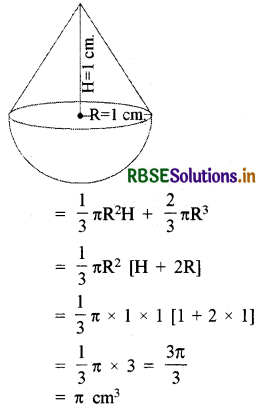
∴ The volume of solid = π cm3
Question 2.
Rachel, an engineering student, was asked to make a model shaped like a cylinder with two cones attached at its two ends by using a thin aluminium sheet The diameter of the model is 3 cm and its length is 12 cm. If each cone has a height of 2 cm, find the volume of air contained in the model that Rachel made. (Assume the outer and inner dimensions of the model to be nearly the same.)
Solution:
Here Radius of cone = Radius of cylinder (R) = \(\frac{3}{2}\) cm
∴ R = 1.5 cm
Height of each cone (h) = 2 cm
∴ Height of cylinder = 12 - 2 - 2 = 8
⇒ H = 8 cm
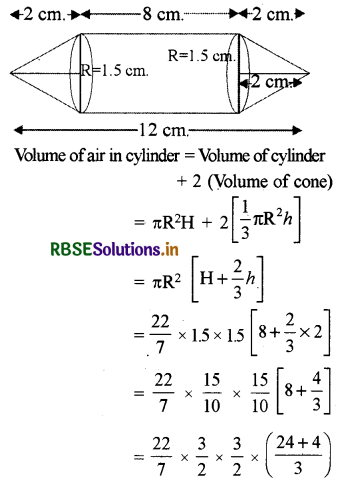
Volume of air in cylinder = \(\frac{22}{7} \times \frac{3}{2} \times \frac{3}{2} \times \frac{28}{3}\)
= 22 × 3
= 66 cm3
Hence volume of air in cylinder = 66 cm3
Question 3.
A gulab jamun contains sugar syrup up to about 30% of its volume. Find approximately how much syrup would be found in 45 gulab jamuns, each shaped like a cylinder with two hemispherical ends with a length of 5 cm and a diameter of 2.8 cm. (see Fig.)
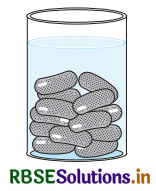
Solution:
Gulab jamun is the shape of a cylinder
Here Diameter of cylinder = Diameter of hemisphere = 2.8 cm
The radius of the cylinder = Radius of the hemisphere
= \(\frac{2.8}{2}\)
= 1.4 cm
R = 1.4 cm
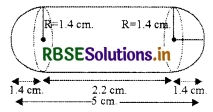
Height of cylindrical portion = 5 - 1.4 - 1.4
= (5 - 2.8) cm
= 2.2 cm
H = 2.2 cm
Volume of a gulab jamun = Volume of cylinder + 2 [Volume of hemisphere]
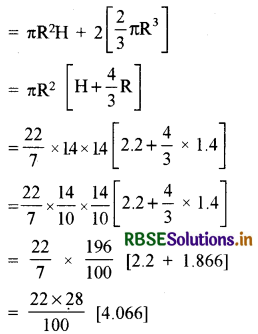
Volume of one gulab jamun = 25.05 cm3
Now volume of 45 gulab jamuns = 45 × 25.05 cm3 = 1127.25 cm3
∴ Volume of sugar syrup = 30% of the volume of 45 gulab jamuns
= \(\frac{30 \times 1127.25}{100}\)
= 338.175 cm3
= 338 cm3 (approx.)
Question 4.
A pen stand made of wood is in the shape of a cuboid with four conical depressions to hold pens. The dimensions of the cuboid are 15 cm by 10 cm by 3.5 cm. The radius of each of the depressions is 0.5 cm and the depth is 1.4 cm. Find the volume of wood in the entire stand (see Fig.).
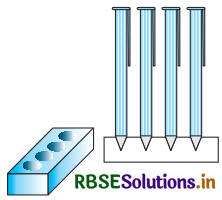
Solution:
According to the question,
Length of cuboid (L) = 15 cm
Breadth of cuboid (B) = 10 cm
Height of cuboid (H) = 3.5 cm
Radius of conical depression (r) = 0.5 cm
Height of conical depression (h)= 1.4 cm
Volume of wood in pen stand = Volume of cuboid - 4 [Volume of Cone]
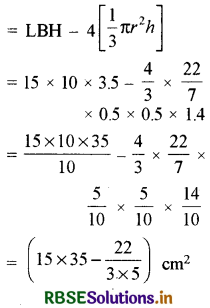
= (525 - 1.466) cm3
= 523.533 cm3
Hence the volume of wood in the entire stand = 523.533 cm3
Question 5.
A vessel is in the form of an inverted cone. Its height is 8 cm and the radius of its top, which is open, is 5 cm. It is filled with water up to the brim. When lead shots, each of which is a sphere of radius 0.5 cm are dropped into the vessel, one-fourth of the water flows out. Find the number of lead shots dropped in the vessel.
Solution:
Radius of cone (R) = 5 cm
Height of cone (H) = 8 cm
Radius of each lead shot (r) = 0.5 cm
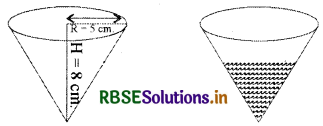
Let the number of shots dropped into the cone = N
Then one-fourth of the water flows out.
N [Volume of one lead shot] = \(\frac{1}{4}\) [Volume of water in the cone]
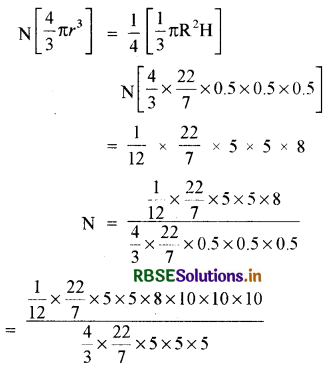
= \(\frac{1}{4 \times 4}\) × 8 × 2 × 10 × 10
= 10 × 10
= 100
Hence the number of lead shots dropped in the vessel = 100
Question 6.
A solid iron pole consists of a cylinder of height 220 cm and base diameter 24 cm, which is surmounted by another cylinder of height 60 cm and radius 8 cm. Find the mass of the pole, given that 1 cm3 of iron has approximately 8g mass. (Use π = 3.14)
Solution:
Diameter of lower cylinder = 24 cm
Radius of lower cylinder (R) = 12 cm
Height of lower cylinder (H) = 220 cm
Radius of upper cylinder (r) = 8 cm
Height of upper cylinder (h) = 60 cm
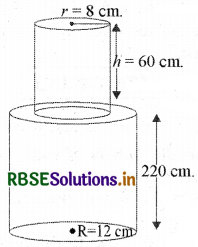
Volume of pole = Volume of lower cylinder + Volume of upper cylinder
= πR2H + πr2h
= 3.14 × 12 × 12 × 220 + 3.14 × 8 × 8 × 60
= 99475.2 + 12057.6
Volume of pole = 111532.8 cm3
Mass of 1 cm3 = 8 gm
Mass of 111532.8 cm3 = 8 × 111532.8
= 892262.4 gm
= \(\frac{892262.4}{1000}\) kg
= 892.2624 kg.
Mass of pole = 892.26 kg
Question 7.
A solid consisting of a right circular cone of height 120 cm and radius 60 cm standing on a hemisphere of radius 60 cm is placed upright in a right circular cylinder full of water such that it touches the bottom. Find the volume of water left in the cylinder, if the radius of the cylinder is 60 cm and its height is 180 cm.
Solution:
Here Radius of cone = Radius of hemisphere = Radius of Cylinder
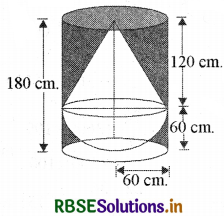
R = 60 cm
Height of cone (h) = 120 cm
Height of cylinder (H) = 180 cm
Volume of cylindrical vessel = πR2H
= \(\frac{22}{7}\) × 60 × 60 × 180
= \(\frac{22}{7}\) × 3600 × 180
The volume of solid dropped into the cylinder = Volume of hemisphere + Volume of a cone
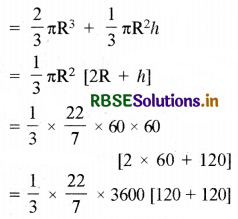
= \(\frac{1}{3} \times \frac{22}{7}\) × 3600 × 240
= \(\frac{22}{7}\) × 3600 × 80
∴ The volume of water that comes out = \(\frac{22}{7}\) × 3600 × 80 cm3
∴ The volume of water left in the cylinder = Volume of the cylinder - Volume of solid dropped into the vessel
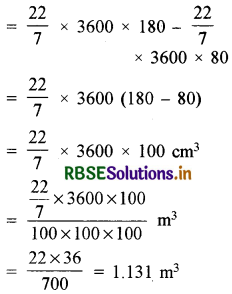
So, the volume of water left in the cylinder = 1.131 m3
Question 8.
A spherical glass vessel has a cylindrical neck 8 cm long, 2 cm in diameter; the diameter of the spherical part is 8.5 cm. By measuring the amount of water it holds, a child finds its volume to be 345 cm2. Check whether she is correct, taking the above as the inside measurement, and π = 3.14.
Solution:
Diameter of neck (cylinderical part) = 2 cm
∴ Radius of neck (r) = 1 cm
Height of cylindrical part (H) = 8 cm
Diameter of spherical part = 8.5 cm
Radius of spherical part (R) = \(\frac{8.5}{2}\) cm = 4.25 cm
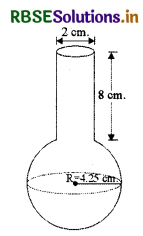
Volume of water in the vessel = Volume of sphere + Volume of cylinder
=\(\frac{4}{3}\) πR3 + πr2H
= \(\frac{4}{3}\) × 3.14 × 4.25 × 4.25 × 4.25 + 3.14 × 1 × 1 × 8
= 321.39 + 25.12
= 346.51 cm3
Volume of water in the vessel = 346.51 cm3

- RBSE Solutions for Class 10 Maths Chapter 6 त्रिभुज Ex 6.3
- RBSE Solutions for Class 10 Maths Chapter 9 त्रिकोणमिति के कुछ अनुप्रयोग Ex 9.1
- RBSE Solutions for Class 10 Maths Chapter 11 रचनाएँ Ex 11.2
- RBSE Solutions for Class 10 Maths Chapter 11 रचनाएँ Ex 11.1
- RBSE Solutions for Class 10 Maths Chapter 8 त्रिकोणमिति का परिचय Ex 8.1
- RBSE Solutions for Class 10 Maths Chapter 7 निर्देशांक ज्यामिति Ex 7.1
- RBSE Solutions for Class 10 Maths Chapter 14 सांख्यिकी Ex 14.3
- RBSE Solutions for Class 10 Maths in Hindi Medium & English Medium
- RBSE Solutions for Class 10 Maths Chapter 15 प्रायिकता Ex 15.2
- RBSE Solutions for Class 10 Maths Chapter 15 प्रायिकता Ex 15.1
- RBSE Solutions for Class 10 Maths Chapter 14 सांख्यिकी Ex 14.4